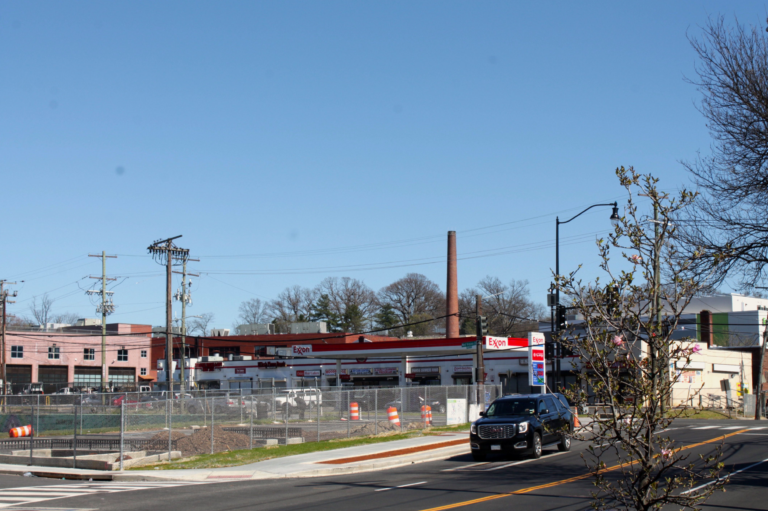By Inshara Ali
Walking the streets of Ivy City in northeast D.C., a distinct smell permeates the residential area. Some say it’s similar to burnt rubber, others say it’s reminiscent of a funeral home. The smell is seemingly traceable to an unassuming building on the corner of Fenwick and Capital Avenue: the National Engineering Products, Inc. (NEP) facility, where sealants for the U.S. Navy are produced.
In 2023, the District of Columbia’s Department of Energy and Environment (DOEE) performed air quality tests around the facility that determined formaldehyde levels were over seven times higher than the EPA’s acceptable exposure levels. Long-term exposure to formaldehyde can lead to respiratory issues, skin rashes, and certain cancers. The air quality tests also found several detections of ethanol, ethylene, acetate and isopropanol near the test site—all chemicals hazardous to human health in high concentrations.
The facility has long been a subject of controversy for residents in the community. The NEP facility predates the EPA’s Clean Air Act of 1970 and several zoning laws in D.C. that would have required it to obtain an air pollution permit and may have stopped it from operating in a residential neighborhood.
Since then, the EPA has established the Ivy City Air Monitoring Project, which will monitor air quality in both residential and nonresidential areas in Ivy City. Sebrena Rhodes, an Ivy City resident, community activist, and Advisory Neighborhood Commissioner, has been working with DOEE and the EPA to resolve concerns about the odor and the health of the community.
“There’s a lot of sickness in our community. We don’t know if it’s from the facility but, if you look at the SDS sheets from the National Engineering Products, a lot of the effects from the chemicals that they’re using are some of the issues that the community members are experiencing,” said Rhodes.
EPA officials addressed residents in a mid-point community meeting in July, stating that the agency doesn’t “have a public health concern.”
Rhodes says she wants to see more from organizations like the DOEE and EPA to address the effects of what she calls a “hazardous” facility.
“They’re not doing their job. And it comes from whoever is in charge of these agencies and whoever has oversight,” Rhodes said. “We don’t know what’s going to happen now with the new administration.”
The effects of air pollution in D.C. disproportionately affect people of color and low-income residents. Some of the highest levels of pollution in the nation’s capital are concentrated in majority-Black neighborhoods–particularly Wards 7 and 8.
“You’ll see it all over the country, where Black and brown communities are being overwhelmed by industrial facilities,” Rhodes said. “This is the only facility in the district that uses the chemicals that they use, and the chemicals are cancer-causing. Why would that be allowed to be in a residential community?”
Ivy City has been subject to years of gentrification, environmental pollution, and difficult living conditions. In the post-Civil War era, Ivy City was initially designated as a suburban development for Black residents, who often lived without heat or power. In the late 1870s, portions of the neighborhood were sold to develop a racetrack, which would later become a railyard enacted by Congress. This began Ivy City’s industrial development phase, when numerous factories, warehouses, and a later electrified railroad began to outstrip the community.
Ivy City’s residents are no stranger to industrial facilities affecting their living conditions. By the mid 1940s, the rail yard owned by Baltimore and Ohio Railroad (B&O) was handling hundreds of coal-fed locomotives, which overwhelmed the residents with soot, smoke, and noise. After the community complained to the city, an investigation found B&O had violated pollution laws and issued fines.
“No matter what we do, it seems like the industries always trump the residents or people, because it’s the money, “ Rhodes said. “If people with money are allowed to have these industries in our backyards—and nobody is stopping them—then we could never coexist with them because they will always cut corners to save money. But these are millionaires and billionaires. And they will sacrifice our environment and people in order to make sure that their industry is making money.”
Still, the community continues to fight for environmental justice and against gentrification. With EmpowerDC, Rhodes and other activists work to document the history of Ivy City and advocate for community improvements. One of their recent successes includes the renovation of the Alexander Crummell School into a community center. The heart of the community since its opening in 1911, the Crummel School was closed by the city in 1972 after enrollment declined. To this day, Ivy City residents have framed pictures of the school in its heyday. Thanks to a 20-year neighborhood campaign, the Crummell School is now being transformed into a community center.



